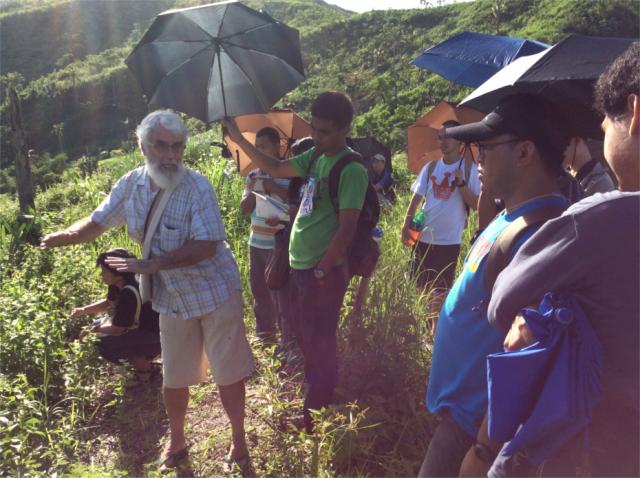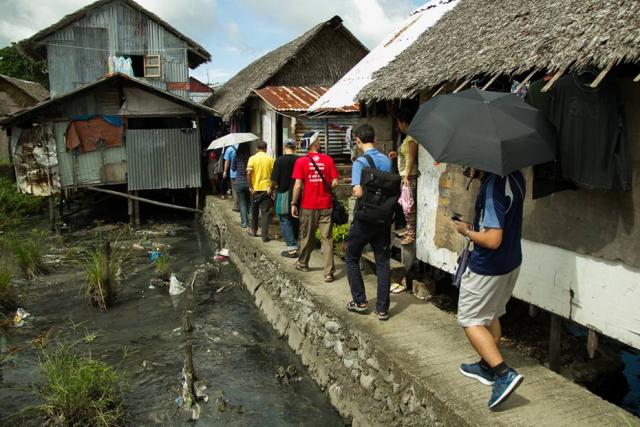From December 17 to January 1, 25 Jesuit scholastics from across the Jesuit Conference of Asia Pacific gathered in Tacloban City – one of the areas hardest hit by Super Typhoon Haiyan –to learn about disaster risk reduction and management, the theme of the 2015 Scholastics and Brothers Circle Workshop. After talks, immersion and reflection, they each had to write a plan for disaster risk reduction and management in their own context. Myanmar scholastic Paul Tu Ja SJ shares this reflection on his experience.
On the first day, we gathered in the Manila Observatory before leaving for Tacloban. There we learned about JCAP’s Protocol for Disaster Risk Reduction and Management (DRRM) from staff and volunteers from Environmental Science for Social Change (ESSC). I was so inspired by this presentation. I felt that I had found an open door to different environmental activities. I felt encouraged to work in line with the deep environmental concern of the Society. However, at some points, I wondered about the actual implementation of the protocol, which was developed in 2012.
 With our knowledge of JCAP’s protocol for DRRM, we proceeded with our workshop in Tacloban. Along the way, JCAP’s Coordinator for Reconciliation with Creation Fr Pedro Walpole SJ helped us understand Laudato si’, Pope Francis’ encyclical on the environment, and the JCAP environmental way of proceeding. We also heard from several people who had accompanied survivors after Super Typhoon Haiyan hit Tacloban City on November 8, 2013. These gave me good foundation to go further with environmental activities in my own context.
With our knowledge of JCAP’s protocol for DRRM, we proceeded with our workshop in Tacloban. Along the way, JCAP’s Coordinator for Reconciliation with Creation Fr Pedro Walpole SJ helped us understand Laudato si’, Pope Francis’ encyclical on the environment, and the JCAP environmental way of proceeding. We also heard from several people who had accompanied survivors after Super Typhoon Haiyan hit Tacloban City on November 8, 2013. These gave me good foundation to go further with environmental activities in my own context.
Later when I visited towns and villages in Tacloban to see and judge the situation two years after Haiyan, three things struck me. First was seeing good collaboration between a Church-based non-governmental organisation and the government. They had very good and systematic structure and coordination. I could sense that the Catholic Church had learned so much about being with the people and standing by their side. The Church has learned to actualize the Gospel’s values in concrete acts that empower the people. I could sense that faith and actions go together among the people in Tacloban. In two years, much work has been done to recover from the disaster.
Second, I was moved by the strong optimism and gratitude of the people who were affected by Haiyan. Despite having lost their property and, for some, their family, they were still able to say, “It’s God’s will and God is right behind us, giving us strength to face it.”
 I was particularly struck by one of the stories from the people in Magay, Tanauan. The first thing they asked for after the typhoon was for a chapel to be built in order that they could draw strength from spiritual power and unity. I was so moved by their faith, the same faith that keeps them alive despite disaster and hardship. Faith is the source of being optimistic and grateful in life.
I was particularly struck by one of the stories from the people in Magay, Tanauan. The first thing they asked for after the typhoon was for a chapel to be built in order that they could draw strength from spiritual power and unity. I was so moved by their faith, the same faith that keeps them alive despite disaster and hardship. Faith is the source of being optimistic and grateful in life.
Third, I was moved by the deep concern of the Society towards our environmental way of proceeding. I am very grateful that Disaster Management was the theme for SBC Workshop 2015. We had a wonderful opportunity to deepen our companionship and learn from one another and I really appreciated all the presentations on environmental issues, current hazards, some possibilities of disasters, and how to manage them.
I am so much inspired and I feel encouraged to introduce and implement simple and workable environmental activities in the two institutes we have in Myanmar. I will encourage the community houses to start simple commitments, such as segregating our garbage and making compost, and being mindful of water and energy usage.
Also, I have come to understand the importance of the protocol for DRRM and I will make extra effort to share it with my fellow Jesuits in Myanmar in our February 2016 Regional meeting.
Related stories:
Scholastics learn how to plan for disasters


